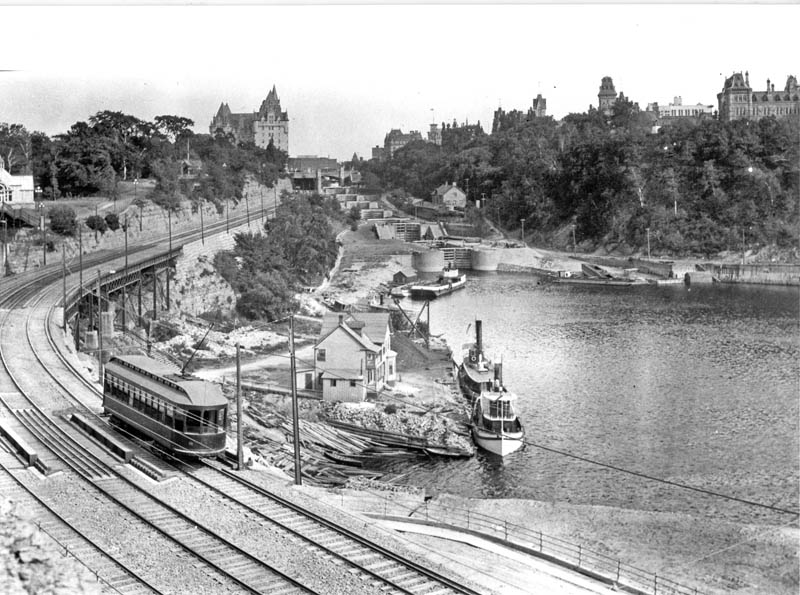 This picture shows where the landslip occurred by the trees in the middle distance. Library and Archives Canada PA45648. Rideau Canal Locks c. 1912, Department of the Interior Collection Item W-4764. Ottawa Citizen 3 April 1945 A fast moving Hull Electric Railway tram car carried 50 charwomen and its motorman safely over 35-foot section of unsupported track 100 feet above the swollen waters of the Ottawa river at 5.30 this morning after a wash-out during the night carried away a portion of a 40-foot-high retaining wall and sent it rolling into the river below. First local car over the line, the tram was a special used for transporting members of the government char service to their work in offices in Ottawa. About an hour and a half earlier, a heavy CPR train, eastbound from Vancouver, passed over the section and railwaymen believe its tremendous weight may have caused the wall, weakened by water seepage and frost, to give way. Motorman H. Holt of the Hull line said that midway across the weakened track his car tilted to a dangerous degree over the edge of the cliff, which drops 40 feet to a slope which angles about 60 feet to the water's edge. Thought car derailed. Fortunately
for the motorman and his passengers the unsupported steel rails held
firmly and the car passed safely to solid ground. There have been
two derailments in the area in recent weeks and at first the motorman
believed that this was what caused his car to lurch dangerously. It was
not until he had brought the tram to a stop and walked back to
investigate that he saw the yawning gap over which the car had passed
and the proximity of the cliff's edge over which the tram might have
rolled had it tilted any further.The washout did not affect the CPR transcontinental main line tracks which adjoin the Hull Electric's road. The network of rails are embedded in a rocky ledge skirting the base of Major's Hill Park. Freight and passenger locomotives of the CPR were able to proceed on regular scheduled runs at slow speed over the weakened section of track. The break occurred about half way between the Hull electric terminal at the Chateau Laurier and the Alexandria bridge. Motorman Holt brought his passengers safely into the terminal and then notified his company and the CPR, owners of the right of way. Start Temporary Wall Section
Foreman Joseph Belisle, 208 Redempteur street, Hull, responded with a
crew of CPR workmen who began the work of clearing away the tons of
rocky debris and the construction of a temporary wooden retaining
wall. A crane was sent from Smiths Falls this afternoon to assist
in the work.The Hull Electric Company put a shuttle service into operation on its east track during the morning to maintain a makeshift service until the west track can be put into operation again. Normal service over the area is not expected to be resumed until tomorrow, however, when the temporary retaining wall should be in place and the gap filled with crushed stone. The retaining wall bordering the right of way was erected some 45 years ago of heavy cut stone, some as large as two feet square, Some of these lurched and thundered down the cliffside to the edge of the river far below, tearing trees from their path and leaving deep gouges in the soft soil of the 60 foot slope. A detailed inspection of the scene revealed that a small underground stream flowing from the high ground of Major's Hill Park some 40 feet above the level of the tracks, had over a period of years undermined the retaining wall. This, together with the almost constant vibration of Hull Electric trams and the heavier CPR trains passing over the right of way, weakened the structure sufficiently to cause it to give way. The wall is about one-half mile long and will be thoroughly inspected for further signs of stress, officials said. Bytown Railway Society, Branchline, November 2010. |